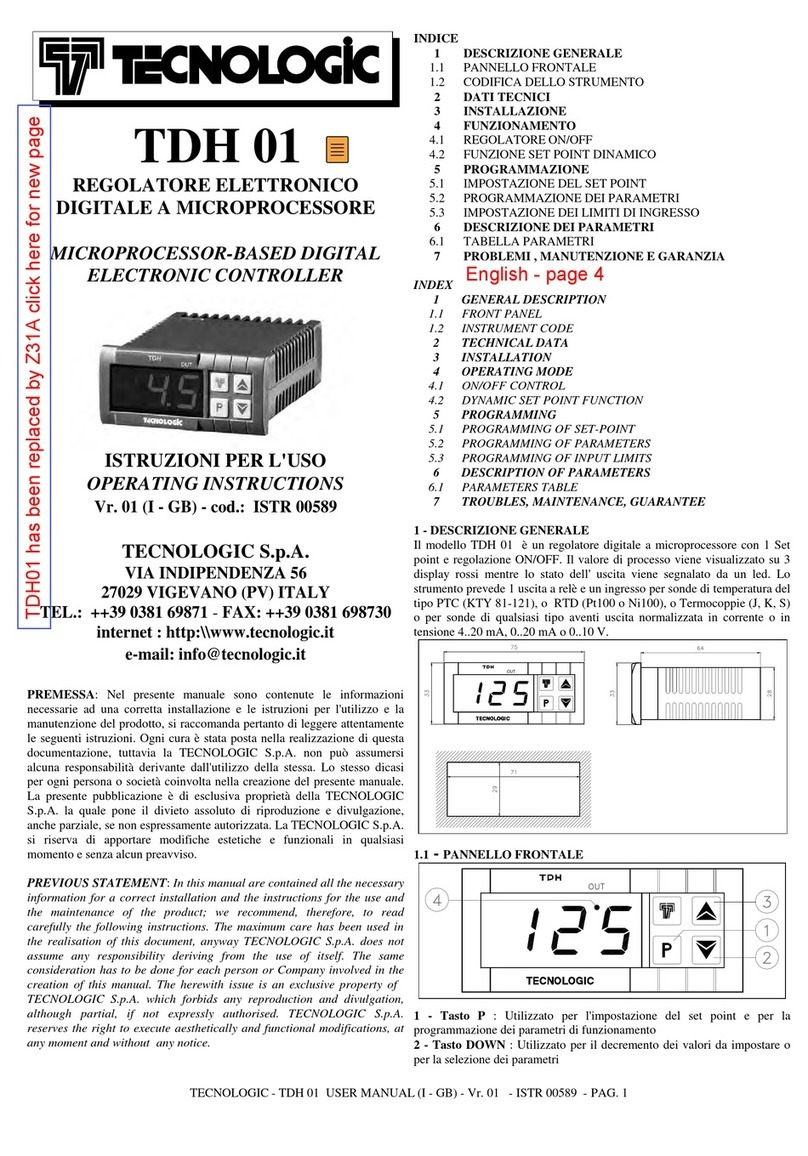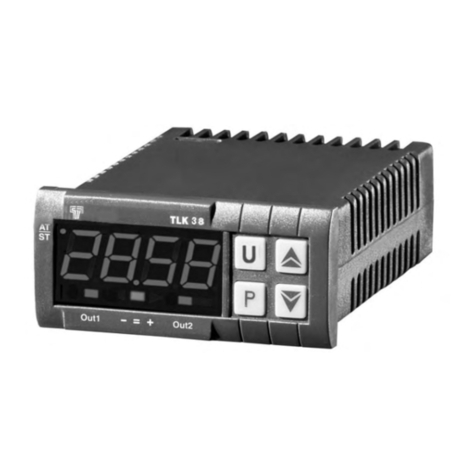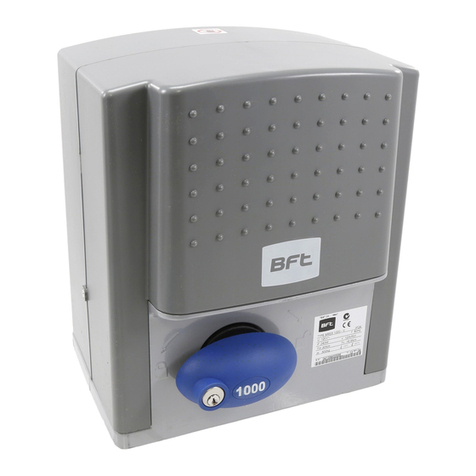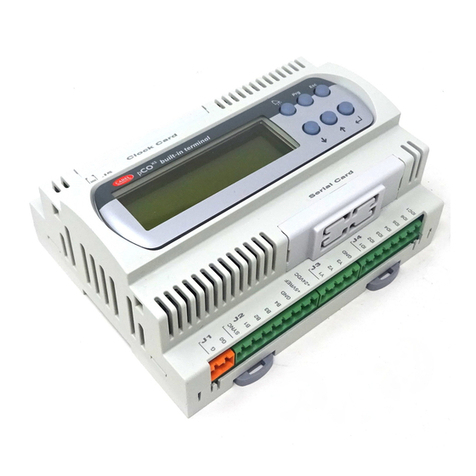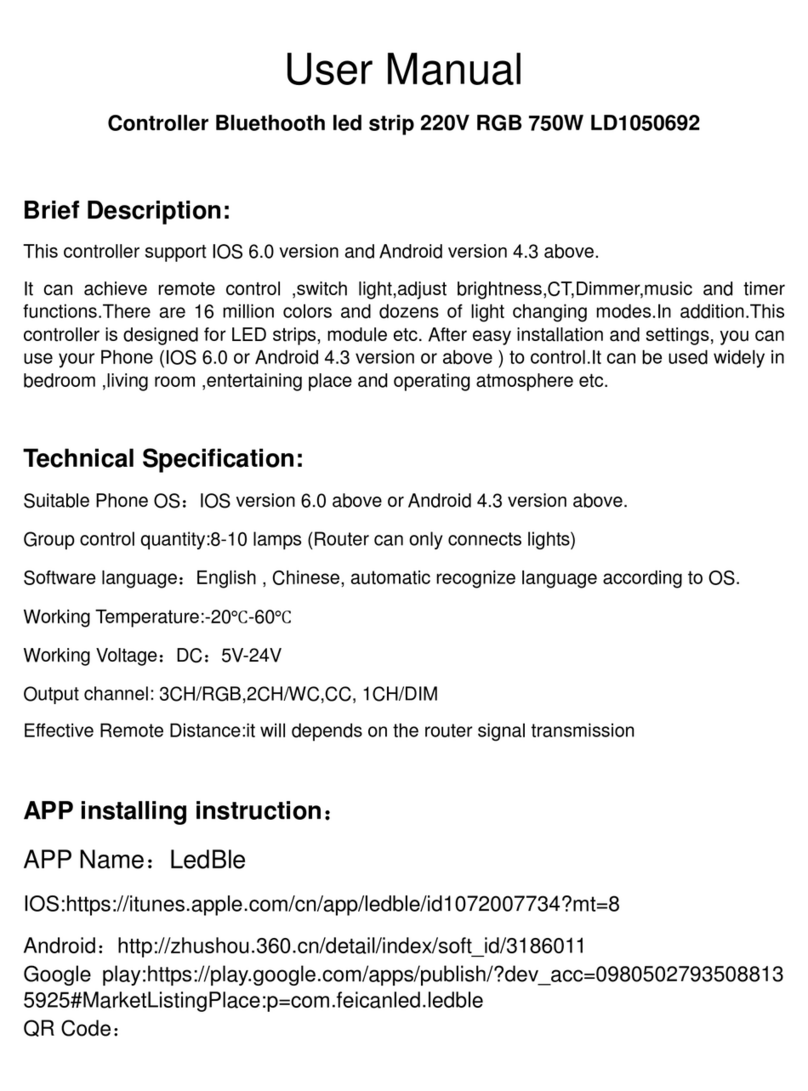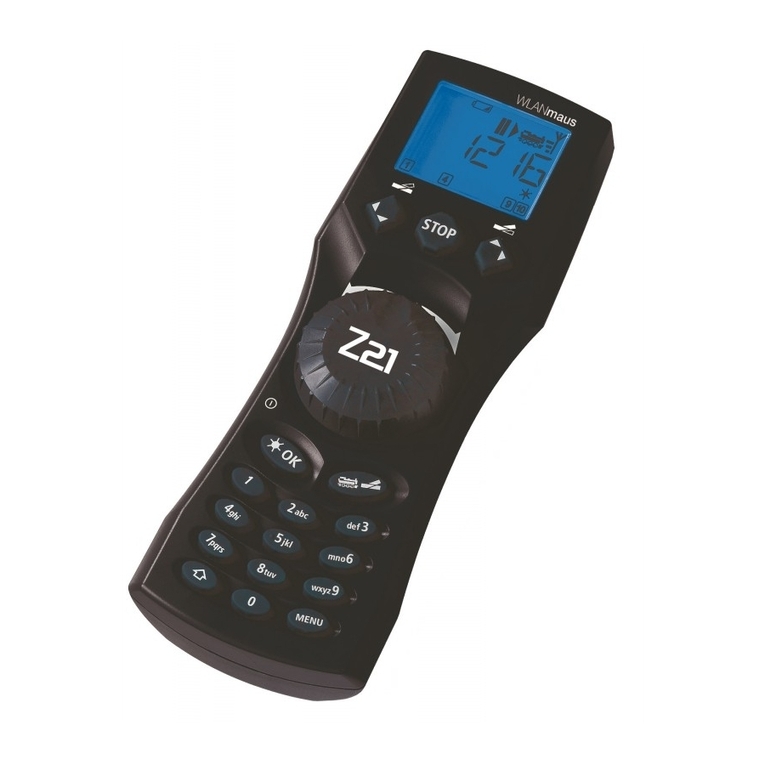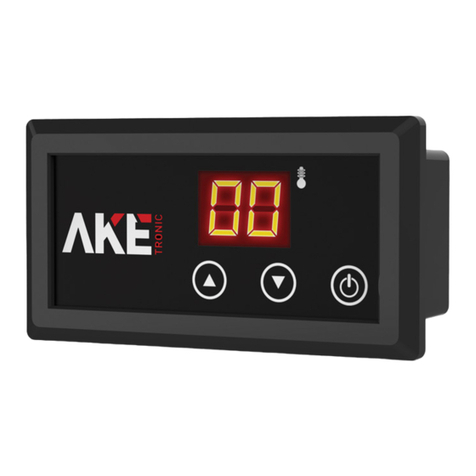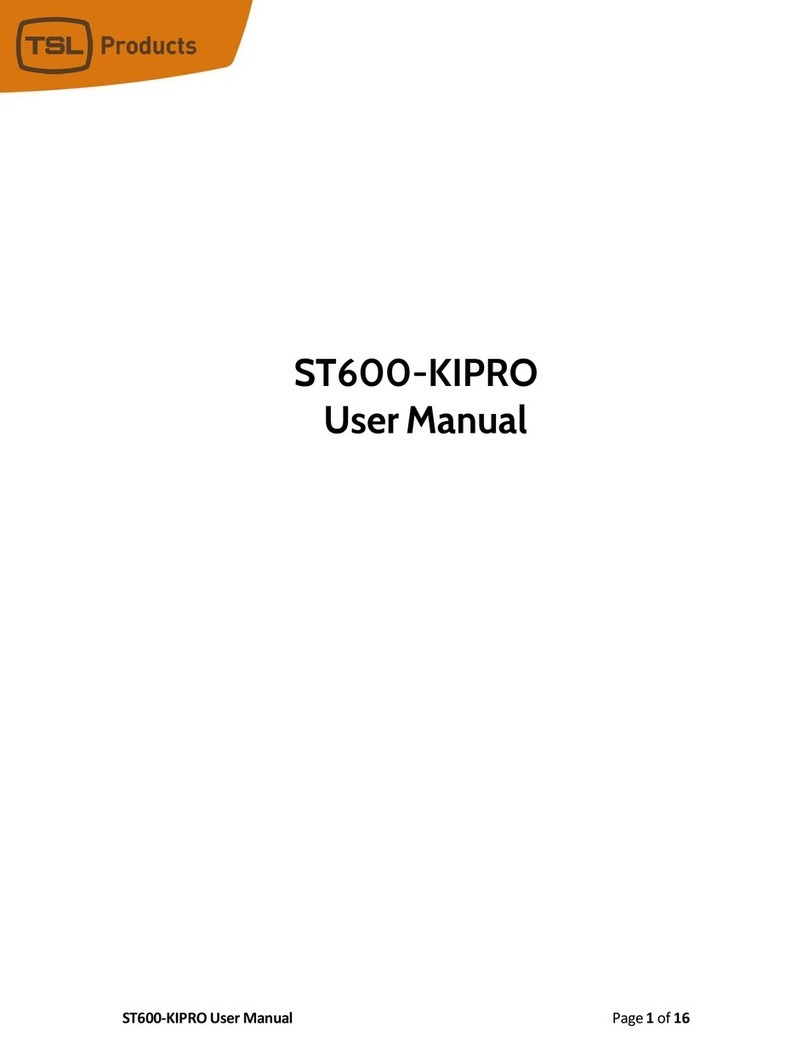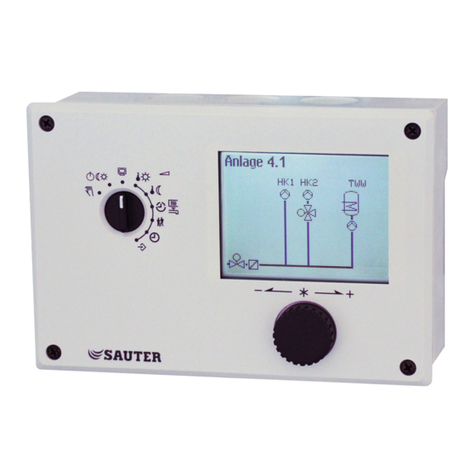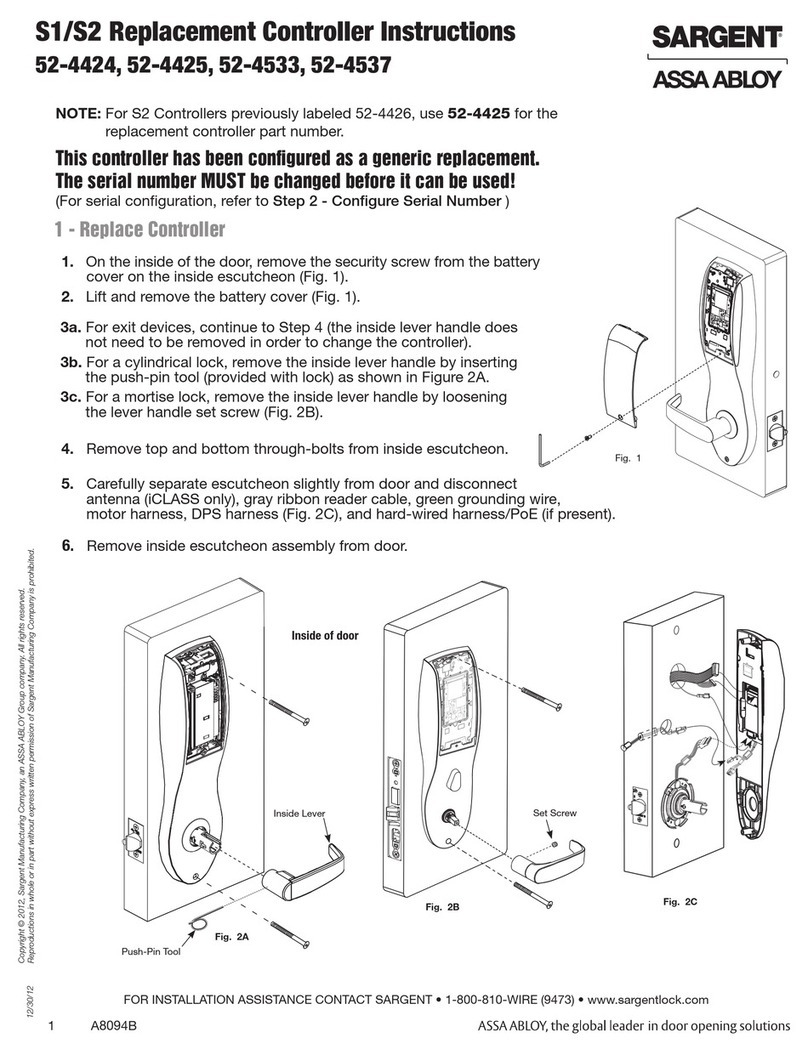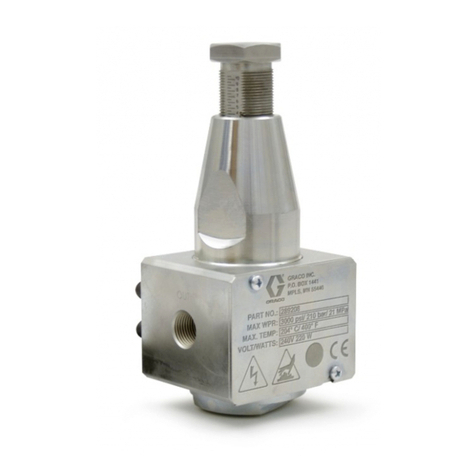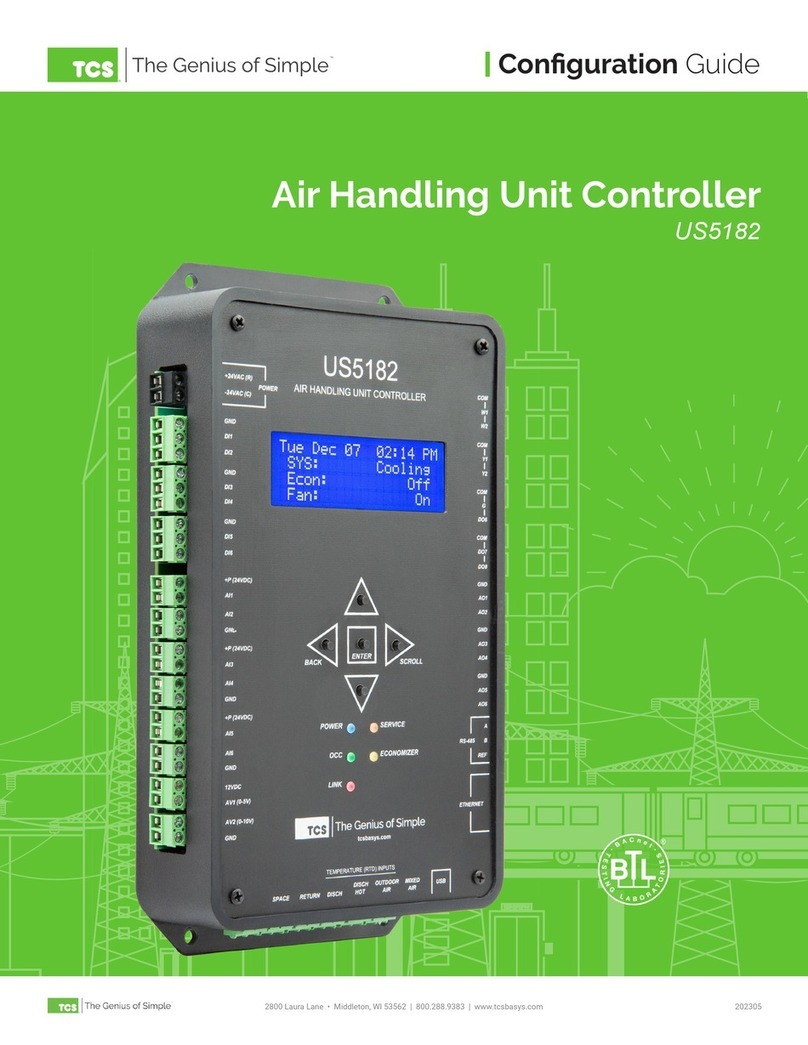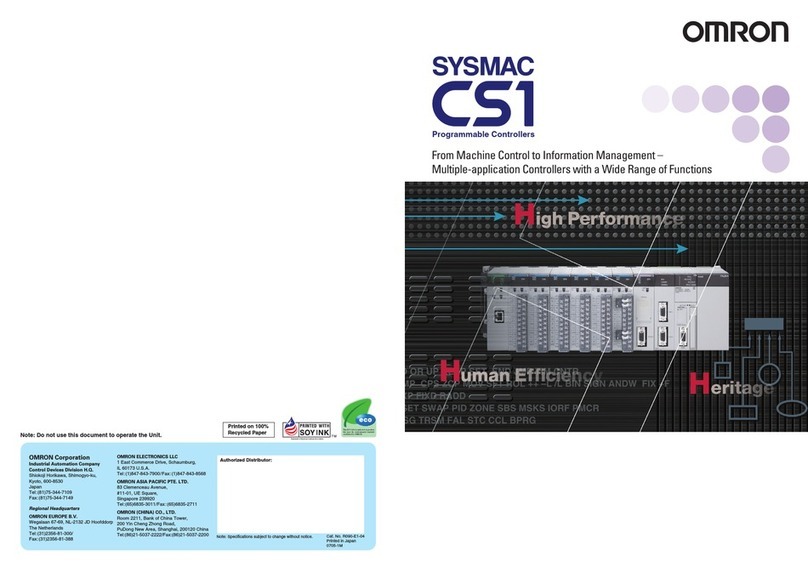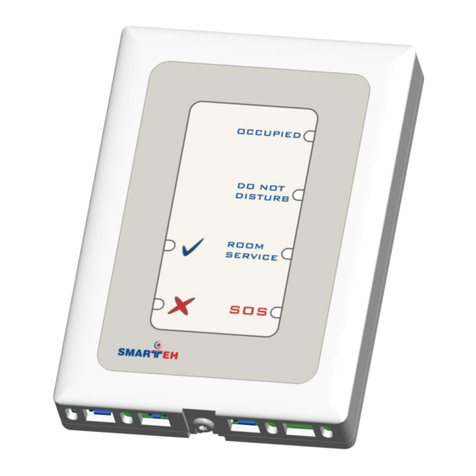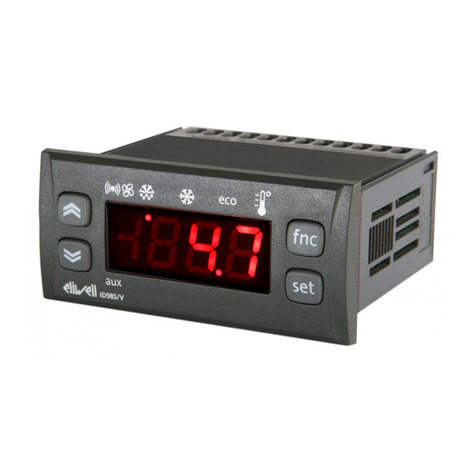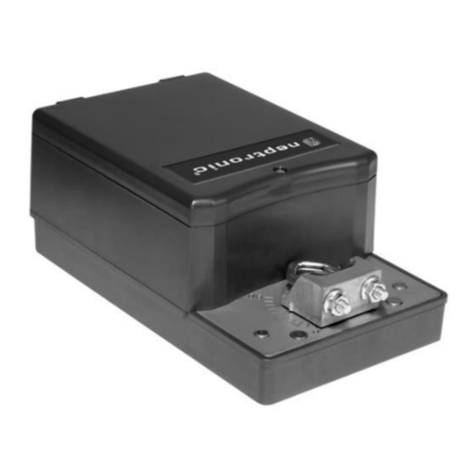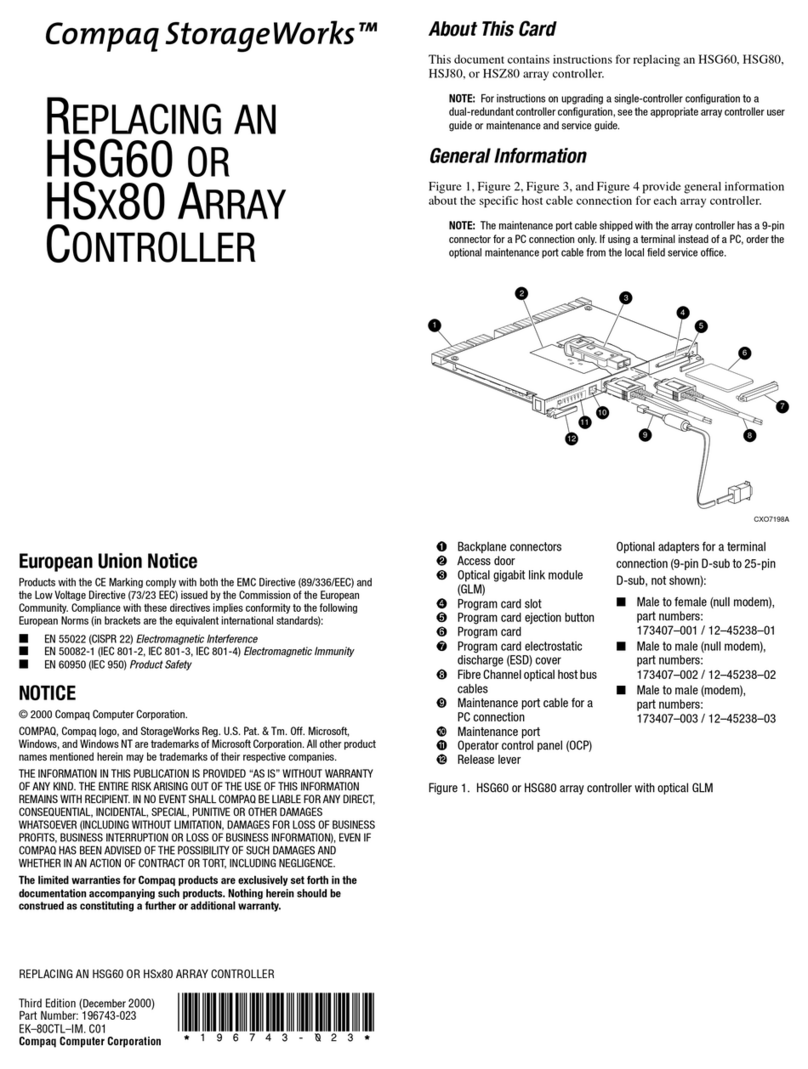Tecnologic TLZ 11 P User manual

TLZ 11 P
MICROPROCESSOR-BASED
DIGITAL ELECTRONIC
THERMOCONTROLLER
OPERATING INSTRUCTIONS
Vr. 01 (ENG) - 09/05 - cod.: ISTR 06947
TECNOLOGIC S.p.A.
VIA INDIPENDENZA 56
27029 VIGEVANO (PV) ITALY
TEL.: +39 0381 69871
FAX: +39 0381 698730
internet : http:\\www.tecnologic.it
e-mail: [email protected]
FOREWORD
This manual contains the information
necessary for the product to be installed
correctly and also instructions for its
maintenance and use; we therefore recommend
that the utmost attention is paid to the following
instructions and to save it.
This document is the exclusive property of TECNOLOGIC
S.p.A. which forbids any reproduction and divulgation , even
in part, of the document, unless expressly authorized.
TECNOLOGIC S.p.A. reserves the right to make any formal or
functional changes at any moment and without any notice.
Whenever a failure or a malfunction of the device may cause
dangerous situations for persons, thing or animals, please
remember that the plant has to be equipped with additional
devices which will guarantee safety.
Tecnologic S.p.A. and its legal representatives do not assume
any responsibility for any damage to people, things or animals
deriving from violation, wrong or improper use or in any case
not in compliance with the instrument’s features.
INDEX
INSTRUMENT ORDERING COD
E
7.5
FUNCTIONAL DATA7.4
MECHANICAL DIMENSIONS, PANEL CUT-OUT AND
MOUNTING
7.3
MECHANICAL DAT
A
7.2
ELECTRICAL DATA7.1
TECHNICAL DATA7
GUARANTEE AND REPAIR
S
6.3
CLEANING6.2
SIGNALLING6.1
PROBLEMS , MAINTENANCE AND GUARANTE
E
6
PROGRAMMABLE PARAMETERS TABLE5
PARAMETERS CONFIGURATION BY KEY014.7
FUNCTION OF KE
Y
“U”4.6
DIGITAL INPUT4.5
EXTERNA
L
A
LARM4.4.2
TEMPERATURE ALARMS4.4.1
A
LARM FUNCTIONS4.4
COMPRESSOR PROTECTION FUNCTION AND DELA
Y
AT POWER-ON
4.3
TEMPERATURE CONTROL4.2
MEASURING AND VISUALIZATION4.1
FUNCTIONS4
ELECTRICAL WIRING DIAGRAM3.4
ELECTRICAL CONNECTION
S
3.3
MECHANICAL MOUNTING3.2
PERMITTED US
E
3.1
INFORMATION ON INSTALLATION AND USE3
ON / STAND-BY FUNCTION2.5
PARAMETERS PROGRAMMING LEVE
L
2.4
PARAMETER PROTECTION USING THE PASSWORD2.3
PARAMETERS PROGRAMMIN
G
2.2
PROGRAMMING OF SET POINT2.1
PROGRAMMING2
FRONT PANEL DESCRIPTION1.2
GENERAL DESCRIPTION1.1
INSTRUMENT DESCRIPTION1
1 - INSTRUMENT DESCRIPTION
1.1 - GENERAL DESCRIPTION
TLZ 11 P is a digital microprocessor based thermocontroller for
Heating or Cooling applications and ON/OFF control mode.
The instrument has up to 2 relay outputs, one input for Pt1000 or
NTC (PT-24C2 up to 300°C) temperature probes and a digital
input, that can be configured.
The 2 outputs can be used for controlling the temperature control
device (OUT) and an alarm (AL).
The instrument is equipped with 4 programme keys, a 4-digit
display and 2 LED signals, in addition to an internal buzzer that is
the sound system for alarms.
Other important characteristics of the instrument are: programme
parameters protection using personalised password, switching on
and off (stand-by) of the instrument using the “U” front key,
configuration of parameters via the KEY 01 device and the
possibility of power supply in the range 100 ... 240 VAC.
1.2 - FRONT PANEL DESCRIPTION
TLZ 11
1
5
2
3
4
Out AL
7
6
1 - Key P : Used for setting the Set point and for programming the
function parameters
2 - Key DOWN : Used for decreasing the values to be set and for
selecting the parameters.
TECNOLOGIC spa - TLZ 11 P- OPERATING INSTRUCTIONS - Vr.01 - 09/05 - ISTR 06947 - PAG. 1

3 - Key UP : Used for increasing the value to be set and for
selecting the parameters.
4 - Key U : It can be programmed via the parameter “USrb” to
turning on and off (stand-by) the device. In the “hidden” parameter
programming mode it’s used to modify the visibility of the
parameters (see par. 2.4).
5 - Led SET : Indicates the input in programming mode and the
programming level of the parameters. It also serves to indicate the
Stand-by status.
6 - Led OUT : Indicates the control output status (or the
temperature control device) on (on), off (off) or inhibited (flashing).
7 - Led AL : Indicates the alarm status (on), off (off) and silenced
(flashing)
2 - PROGRAMMING
2.1 - PROGRAMMING OF THE SET POINT
Press the key Pthen release it and the display will show SP
alternating with the set value.
To change it press the UP key to increase the value or DOWN to
decrease it.
These keys increase or decrease the value one digit at a time, but
if the button is pressed for more than one second the value
increase or decreases rapidly, and after two seconds pressed, the
speed increases even more to all the desired valued to be reached
rapidly.
Exiting the Set mode is achieved by pressing the P key or
automatically if no key is pressed for 15 seconds. After that time
the display returns to the normal function mode.
2.2 - PARAMETERS PROGRAMMING
To access the instrument’s function parameters, press the key P
and keep it pressed for about 5 seconds, after which the SET led
will light up, the display will visualised the code that identifies the
first parameter.
Using the UP and DOWN keys, the desired parameter can be
selected and pressing the P key, the display will alternately show
the parameter code and its setting that can be changed with the UP
and DOWN keys.
Once the desired value has been set, press the key P again: the
new value will be memorised and the display will show only the
code of the selected parameter.
Pressing the UP and DOWN keys, it is possible to select another
parameter and change it as described.
To exit the programming mode, do not press any key for about 20
seconds, or keep the UP or DOWN key pressed until it exits the
programming mode.
2.3 - PARAMETER PROTECTION USING THE PASSWORD
The instrument has a parameter protection function using a
password that can be personalised, through the “PASS”
parameter.
If one wishes to have this protection, set the password number
desired in the parameter “PASS”.
When the protection is working, press the P key to access the
parameters and keep it press for about 5 seconds, after which the
LED SET will flash and the display will show “0” .
At this point, using the UP and DOWN keys, set the password
number programmed and press the key "P".
If the password is correct, the display will visualise the code that
identifies the first parameter and it will be possible to programme
the instrument in the same ways described in the previous section.
Protection using a password can be disabled by setting the
parameter “PASS” = OFF.
2.4 - PARAMETERS PROGRAMMING LEVELS
The instrument has two parameter programming levels.
The first level (“visible” parameters) is accessed according to the
procedure described above (with or without password request)
while the second level (“hidden” password) can be accessed
according to the following procedure.
Remove the power supply to the instrument, press the key P and
return power to the instrument, keeping the key pressed.
After about 5 sec. the SET led will light up, the display will show the
code that identifies the first parameter and it will be possible to set
the parameters of the instrument using the same programming
procedure described previously.
Once the parameter has been selected and the SET is on, it means
that the parameter can be programmed even on the first level
("visible”).
If the LED is off it means that the parameter can only be
programmed on this level (i.e. “hidden”).
To change the visibility of the parameter, press the key U: the led
SET will change status, indicating the accessibility level of the
parameter (on = parameter “visible”; off = parameter “hidden”).
The access procedure for “hidden” parameters allows the “PASS”
parameter to be checked and changed, and is useful therefore if
the password set has been forgotten.
2.5 - ON / STAND-BY FUNCTION
The instrument, once powered up, can assume 2 different
conditions:
- ON : means that the controller uses the control functions.
- STAND-BY : means that the controller does not use any control
function and the display is turned off except for the green SET led.
If there is no power, and then power returns, the system always
sets itself in the condition it was in before the black-out.
The ON/Stand-by function can be selected using the key U if the
parameter "USrb" = 1 (see par. 4.6)
3 - INFORMATION ON INSTALLATION AND US
E
3.1 - PERMITTED USE
The instrument has been projected and
manufactured as a measuring and control device to
be used according to EN61010-1 for the altitudes
operation until 2000 ms. The use of the instrument
for applications not expressly permitted by the
above mentioned rule must adopt all the necessary protective
measures. The instrument CANNOT be used in dangerous
environments (flammable or explosive) without adequate
protection. The installer must ensure that EMC rules are respected,
also after the instrument installation, if necessary using proper
filters. Whenever a failure or a malfunction of the device may cause
dangerous situations for persons, thing or animals, please
remember that the plant has to be equipped with additional devices
which will guarantee safety.
3.2 - MECHANICAL MOUNTING
The instrument, in case 33 x 75 mm, is designed for flush-in panel
mounting. Make a hole 29 x 71 mm and insert the instrument, fixing
it with the provided special bracket. We recommend that the gasket
is mounted in order to obtain the front protection degree as
declared. Avoid placing the instrument in environments with very
high humidity levels or dirt that may create condensation or
introduction of conductive substances into the instrument. Ensure
adequate ventilation to the instrument and avoid installation in
containers that house devices which may overheat or which may
cause the instrument to function at a higher temperature than the
one permitted and declared. Connect the instrument as far away as
possible from sources of electromagnetic disturbances such as
motors, power relays, relays, solenoid valves, etc.
3.3 - ELECTRICAL CONNECTION
Carry out the electrical wiring by connecting only one wire to each
terminal, according to the following diagram, checking that the
power supply is the same as that indicated on the instrument and
that the load current absorption is no higher than the maximum
electricity current permitted.
As the instrument is built-in equipment with permanent connection
inside housing, it is not equipped with either switches or internal
devices to protect against overload of current: the installation will
include an overload protection and a two-phase circuit-breaker,
placed as near as possible to the instrument, and located in a
position that can easily be reached by the user and marked as
TECNOLOGIC spa - TLZ 11 P- OPERATING INSTRUCTIONS - Vr.01 - 09/05 - ISTR 06947 - PAG. 2

instrument disconnecting device which interrupts the power supply
to the equipment.
It is also recommended that the supply of all the electrical circuits
connected to the instrument must be protect properly, using
devices (ex. fuses) proportionate to the circulating currents.
It is strongly recommended that cables with proper insulation,
according to the working voltages and temperatures, be used.
Furthermore, the input cable of the probe has to be kept separate
from line voltage wiring. If the input cable of the probe is screened,
it has to be connected to the ground with only one side.
Whether the instrument is 12 V version it’s recommended to use
an external transformer TCTR, or with equivalent features, and to
use only one transformer for each instrument because there is no
insulation between supply and input.
We recommend that a check should be made that the parameters
are those desired and that the application functions correctly before
connecting the outputs to the actuators so as to avoid
malfunctioning that may cause irregularities in the plant that could
cause damage to people, things or animals.
3.4 - ELECTRICAL WIRING DIAGRAM
SUPPLY
Pt1000-NTC DIG.
SPDT 5A-AC1
21
TLZ 11 P
CCNCNO
OUT
534 76
SPDT 16A-AC1
NO C
SPST-NO 16A-AC1
NCNO INPUTS
1089
ALARM
1211
PROBE
INTERNAL
BUZZER
4 - FUNCTIONS
4.1 - MEASURING AND VISUALIZATION
Via the parameter “SEnS” it is possible to select the type of
probes that one wishes to use and which can be:
Thermoresistances PT1000 (Pt10) or thermistores NTC PT-24C2
(Entc).
Once the type of probe used has been selected, through the
parameter “Unit”, it is possible to select the temperature unit of
measurement (°C or °F) and, through the parameter “dP”, the
resolution of the desired measurement (OFF=1°; On =0,1°).
The instrument allows the measuring to be calibrated, that can be
used for re-calibrating the instrument according to application
needs, through the parameters “OFS”.
Using the parameter “FiL”, it is possible to set the time constant
for the software filter for measuring the input values to be able to
reduce the sensitivity to measurement disturbances (increasing the
time).
4.2 - TEMPERATURE CONTROL
The regulation of the instrument is ON/OFF and acts on the output
“OUT” depending on the measuring of probe, of the Set Point
“SP”, the intervention differential “HSEt” and the function mode
“Func” .
Depending on the function mode programmed on the parameter
“Func” the differential is automatically considered by the regulator
with positive values for a Refrigeration control (“Func”=CooL) or
with negative values for a heating control (“Func”=HEAt).
In the event of probe error, it is possible to set the instrument so
that that the output “OUT” continues to work in cycles according to
the times programmed in the parameter “tonE” (activation time)
and “toFE” (deactivation time).
If an error occurs on the probe the instrument activates the output
for the time “tonE”, then deactivates it for the time “toFE” and so on
whilst the error remains.
Programming “tonE” = OFF lthe output in probe error condition will
remain switched off.
Programming instead “tonE” to any value and “toFE” = OFF the
output in probe error condition will remain switched on.
Remember that the temperature regulation function can be
conditioned by the “Compressor Protection” function described
below.
OUT
SP
Temp.
off
ON
HEAt
OUT
time
HSEt
SP
Temp.
HSEt
time
CooL
ON ONON ON ON
offoff off
4.3 - COMPRESSOR PROTECTION FUNCTION AND DELAY AT
POWER-ON
The function “Compressor Protection” carried out by the machine
aims to avoid close start ups of the compressor controlled by the
instrument in cooling applications.
This function foresees a time control on the switching on of the
“OUT” output associated with the temperature regulation request.
The protection consists of preventing the output being switched on
during the time set in the parameter “PtC” and counted depending
on what has been programmed in the parameter “PSC”, and
therefore that any activation occurs only after the “PtC” time has
finished.
If during the power on delay phase, the regulator request should
disappear, due to an inhibition caused by the compressor
protection function, the foreseen start up of the output is naturally
cancelled.
Using the parameter "PSC", it is possible to set the type of
compressor protection and therefore from when the inhibition time
“PtC” must start.
The parameter “PSC” can be set as:
= 1 : Power on delay
Temp.
OUT
PtC
off
ON
SP
PtCPtC
"P S C " = 1
tim e
HSEt
off off off
ON ON
= 2 : Delay after power off
ON
OUT
off
PtC PtC PtC
SP
Temp.
"PSC" = 2
tim e
HSE
t
ON ON
off off
= 3 : Delay between power on phases.
PtC
OUT
off
SP
ON
Temp.
PtC PtC
tim e
HSEt
"PSC" = 3
off off
ON ON
The function is disabled by programming “PtC” = 0.
During the power on delay phases of the OUT output by inhibiting
the function “Compressor Protection” the led OUT flashes.
TECNOLOGIC spa - TLZ 11 P- OPERATING INSTRUCTIONS - Vr.01 - 09/05 - ISTR 06947 - PAG. 3

It is also possible to prevent activation of the output after the
instrument is turned on, for the time set in the parameter “od”.
The function is disabled by “od” = OFF.
During the power on delay phase, the display shows the indication
od, alternating with the normal programmed visualisation.
4.4 - ALARM FUNCTIONS
The alarm functions of the instrument work on the led AL, on the
internal buzzer (if present) and on the output AL (if present)
The buzzer are activated in alarm conditions and can be disabled
(alarm silencing) manually by pressing any key of the instrument .
Any active alarm is shown on the instrument display with the
lighting up of the AL led .
Any silenced alarm status is shown by the AL led flashing .
The output AL are activated in alarm status but cannot be disabled
manually and are therefore only disabled when the alarm status
ceases.
The alarm conditions of the instrument are:
- Probe errors “E1”, “-E1”
- temperature alarms “HI” and “LO”
- External alarms “AL”
4.4.1 - TEMPERATURE ALARMS
The temperature alarms, that are relative type, work according to
the probe measurement, the alarm thresholds set in parameters
“HAL” (maximum alarm) and “LAL” (minimum alarm) and the
relative differential “dAL”.
Using some parameters it is also possible to delay the
enablement and the intervention of these alarms.
These parameters are:
“PAL” - is the temperature alarm exclusion time on switching on
the instrument if the instrument is in alarm status when it is
switched on.
“ALd” - is the temperature alarm delay activation time
The temperature alarm is enabled at the end of exclusion time and
is enabled after the “ALd” time when the temperature measured by
the probe exceeds the value [”SP”+”HAL”] or or goes below the
value [”SP”-”LAL”].
The maximum and minimum temperature alarms can be disabled
by setting the relative parameters "HAL" and "LAL" = OFF.
At the same time as the signalling of the alarm device (buzzer and
output AL), the instrument signals the alarm by turning on the led
light AL, and visualises on the display:
- Alternately HI and the measured temperature for maximum alarm
- Alternately LO and the measured temperature for the minimum
alarm
tim e
dAL
dAL
AL
off
ON
HI
LAL
SP
HAL
Temp.
LO
off off
ON
4.4.2 - EXTERNAL ALARM
The instrument can signal an external alarm by activating the digital
input with the function programmed as “diF” = 3 (see par. 4.5).
At the same time as the signalling of the alarm (buzzer and/or
output), the instrument signals the alarm by turning on the led AL
and visualising AL and the measured temperature alternately on
the display.
4.5 - DIGITAL INPUT
The digital input present on the instrument accepts contacts free of
voltage, the function carried out is defined by the parameter “diF”.
The parameter “diF” can be configured for the following functions:
= 0 , = 1, = 2, = -1, = -2 - Digital input not active
= 3 - External alarm signal with contact normally open: on closing
the input the alarm is activated and the instrument visualises AL
and the measured temperature alternately on the display.
= -3 - External alarm signal with contact normally closed : similar to
“diF”=3 but with function logic reversed.
4.6 - FUNCTIONING OF KEY “U”
The U key function can be defined by the parameter “USrb” and
can be configured for the following functions:
= OFF - The key U carries out no function.
= 1 - Pressing the key for at least 1 second, it is possible to switch
the instrument from the ON status to Stand-by status and vice
versa.
4.7 - PARAMETERS CONFIGURATION BY “KEY01”
The instrument is equipped with a connector that allows the
transfer from and toward the instrument of the functioning
parameters through the device TECNOLOGIC KEY01 with 5 poles
connector.
This device it’s mainly useable for the serial programming of the
instruments which need to have the same parameters configuration
or to keep a copy of the programming of an instrument and allow its
rapid retransmission.
To use the device KEY01 it’s necessary that the device or
instrument are being supplied.
Instrument supplied and device not supplied
SUPPLY
Instrument supplied from the device
SUPPLY ADAPTER
12 VDC AC SUPPLY
For additional info, please have a look at the KEY01 instruction
manual.
5 - PROGRAMMABLE PARAMETERS TABLE
Here below is a description of all the parameters available on the
instrument. Some of them may not be present, either due to the
fact they depend on the type of instrument or because they are
automatically disabled as unnecessary.
2.00.0 ÷ 30.0
°C/°F
Differential
HSEt
8
2.0OFF ÷ 20.0
sec
Measurement filter
FiL
7
OnOn - OFFDecimal point
dP
6
°C°C - °FUnit of measurement
Unit
5
0.0-30.0 ÷ 30.0
°C/°F
Probe Calibration
OFS
4
Pt10Pt10 - EntcProbe Type:
Pt10= Pt1000
Entc= NTC (PT-24C2)
SEnS
3
500.0SPLL ÷ 932.0Maximum Set Point
SPHL
2
-99.0-99.9 ÷ SPHLMinimum Set Point
SPLL
1
NoteDef.RangeDescriptionPar.
TECNOLOGIC spa - TLZ 11 P- OPERATING INSTRUCTIONS - Vr.01 - 09/05 - ISTR 06947 - PAG. 4

0.0SPLL ÷ SPHLSet Point
SP
23
OFFOFF ÷ 9999Access Password to
parameter functions
PASS
22
0-3 / -2 / -1 / 0
/ 1 / 2 / 3
Function and function
logic of digital input:
0, 1, 2 = No function
3= External alarm
diF
21
OFFOFF / 1Function mode key U:
OFF= No Function
1= ON/STAND-BY
USrb
20
2.00OFF ÷ 24.00
hrs.min
Temperature Alarms
delay at power on
PAL
19
OFFOFF ÷ 99.59
min.sec
Temperature Alarms
dela
y
ALd
18
2.00.0 ÷ 30.0
°C/°F
Temperature Alarms
Differential
dAL
17
OFFOFF ÷ 100.0
°C/°F
Relative Low
temperature Alarm
threshold
LAL
16
OFFOFF ÷ 100.0
°C/°F
Relative High
temperature Alarm
threshold
HAL
15
OFFOFF ÷ 99.59
min.sec
Delay at power on
od
14
OFFOFF ÷ 99.59
min.sec
Compressor protection
time
PtC
13
11 - 2 - 3Type of compressor
protection:
1= delay at switch on
2= delay after switch off
3= delay between starts
PSC
12
CooLHEAt - CooLFunction mode output
OUT
Func
11
OFFOFF ÷ 99.59
min.sec
Deactivation time out-
put OUT for probe
broken
toFE
10
OFFOFF ÷ 99.59
min.sec
Activation time output
OUT for probe broken
tonE
9
6 - PROBLEMS, MAINTENANCE AND GUARANTE
E
6.1 - SIGNALLING
Error Signalling:
Check and if necessary
re-programme the
parameters function.
Internal memory error
EEPr
Check the correct
connection of the probe
with the instrument and
check the probe works
correctly
The probe may be
interrupted or in short
circuit, or may measure
a value outside the
range allowed
E1
-E1
ActionReasonError
In probe error status, the output OUT behaves as set by the
parameters “tonE” and “toFE”.
Other Signalling:
Digital input alarm in progress
AL
Minimum temperature alarm in progress
LO
Maximum temperature alarm in progress
HI
Delay in switching on in progress
od
ReasonMessage
6.2 - CLEANING
We recommend cleaning of the instrument with a slightly wet cloth
using water and not abrasive cleaners or solvents which may
damage the instrument.
6.3 - GUARANTEE AND REPAIRS
The instrument is under warranty against manufacturing flaws or
faulty material, that are found within 12 months from delivery date.
The guarantee is limited to repairs or to the replacement of the
instrument.
The eventual opening of the housing, the violation of the instrument
or the improper use and installation of the product will bring about
the immediate withdrawal of the warranty’s effects.
In the event of a faulty instrument, either within the period of
warranty, or further to its expiry, please contact our sales
department to obtain authorisation for sending the instrument to
our company.
The faulty product must be shipped to TECNOLOGIC with a
detailed description of the faults found, without any fees or charge
for Tecnologic, except in the event of alternative agreements.
7 - TECHNICAL DATA
7.1 - ELECTRICAL DATA
Power supply: 12 VAC/VDC, 24 VAC/VDC, 100..240 VAC +/- 10%
Frequency AC: 50/60 Hz
Power consumption: 3 VA approx.
Input/s: 1 input for temperature probes: Pt1000 or NTC (PT-24C2,
100 K Ω@ 25 °C); 1 digital input for free voltage contacts
Output/s: up to 2 relay outputs: OUT SPST-NO (16A-AC1, 6A-AC3
250 VAC) or SPDT 16A-AC1, 6A-AC3 250 VAC) and AL SPST-NO
(5A-AC1, 2A-AC3 250 VAC).
Electrical life for relay outputs: OUT SPST-NO: 100000 op. ; SPDT:
50000 op. (om. VDE); AL: 100000 op.
Installation category: II
Measurement category: I
Protection class against electric shock: Class II for Front panel
Insulation: Reinforced insulation between the low voltage part
(supply H type and relay outputs) and front panel; Reinforced
insulation between the low voltage section (supply type H and relay
outputs) and the extra low voltage section (inputs); Reinforced
between supply and relay outputs; No insulation between supply F
type and inputs.
7.2 - MECHANICAL DATA
Housing: Self-extinguishing plastic, UL 94 V0
Dimensions: 33 x 75 mm, depth 64 mm
Weight: 115 g approx.
Mounting: Flush in panel in 29 x 71 mm hole
Connections: 2,5 mm
2
screw terminals block
Degree of front panel protection : IP 65 mounted in panel with
gasket
Pollution situation: 2
Operating temperature: 0 ... 50 °C
Operating humidity: 30 ... 95 RH% without condensation
Storage temperature: -10 ... +60 °C
7.3 – MECHANICAL DIMENSIONS, PANEL CUT-OUT AND
MOUNTING [mm]
75
33
5
64
28
Out AL
TLZ 11
RECOMMENDED
PANEL CUTOUT
29
71
min. 15 mm
min. 12 mm
TECNOLOGIC spa - TLZ 11 P- OPERATING INSTRUCTIONS - Vr.01 - 09/05 - ISTR 06947 - PAG. 5

TYPE 1
PANEL + GASKET
PANEL + GASKET
TYPE 2
BRACKET
TYPE 1
BRACKETS
TYPE 2
86
74
43
31
34
MAX 12 mm
MAX 29 mm
7.4 - FUNCTIONAL FEATURES
Temperature Control: ON/OFF mode
Measurement range: Pt1000 : -100 ... 500 °C (-99,9 ... 500,0 °C) /
-148 ... 932 °F (-99,9 ... 932,0 °C); NTC (PT-24C2) : 0...300 °C / 32
...572 °F
Display resolution: 1 ° or 0,1°
Overall accuracy: Pt1000 : +/- (0,5 % fs + 1 digit); NTC (PT-24C2)
: +/- (1 % fs + 1 digit)
Sampling rate: 130 ms.
Display: 4 Digit Red h 12 mm
Compliance: ECC directive EMC 89/336 (EN 61326), ECC directive
LV 73/23 and 93/68 (EN 61010-1)
7.5 - INSTRUMENT ORDERING CODE
TLZ 11 a b c d ee P
a : POWER SUPPLY
H= 100...240 VAC
L= 24 VAC/VDC
F= 12 VAC/VDC
b : OUTPUT OUT TYPE
S= Relay SPDT 16A-AC1
R= Relay SPST-NO 16A-AC1
c : ALARM OUTPUT
R = Relay
-= None
d : INTERNAL BUZZER
B= Yes
-= No
ee : SPECIAL CODES
TECNOLOGIC spa - TLZ 11 P- OPERATING INSTRUCTIONS - Vr.01 - 09/05 - ISTR 06947 - PAG. 6
Table of contents
Other Tecnologic Controllers manuals
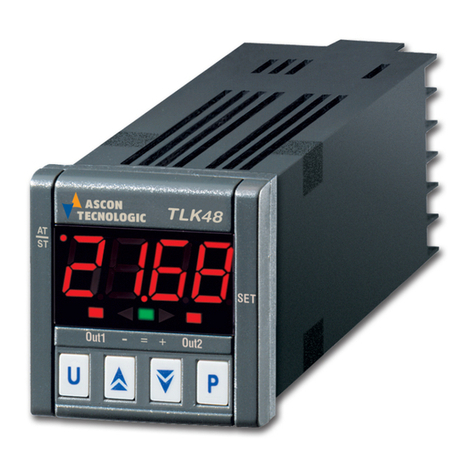
Tecnologic
Tecnologic TLK 48 User manual
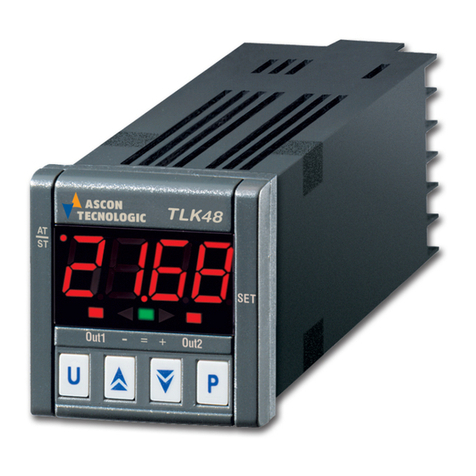
Tecnologic
Tecnologic TLK 48 B User manual
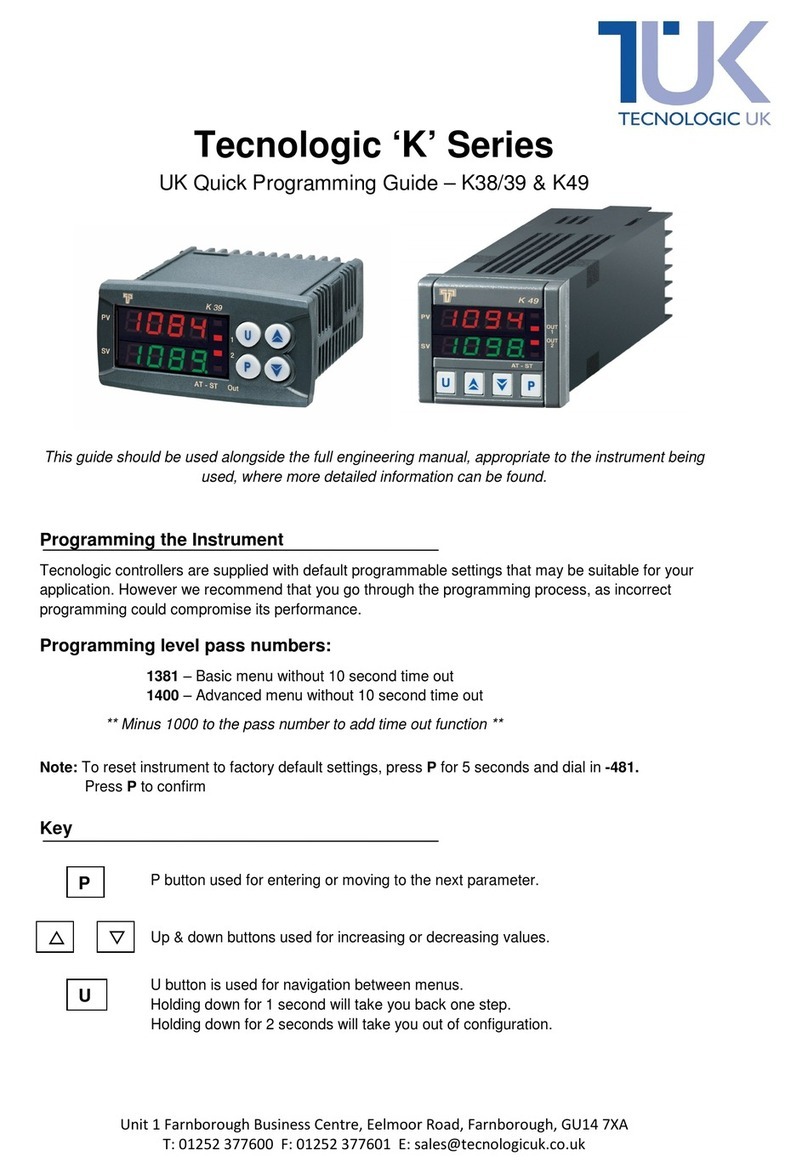
Tecnologic
Tecnologic K series Operating instructions

Tecnologic
Tecnologic THP 96 User manual

Tecnologic
Tecnologic K Series Operating instructions
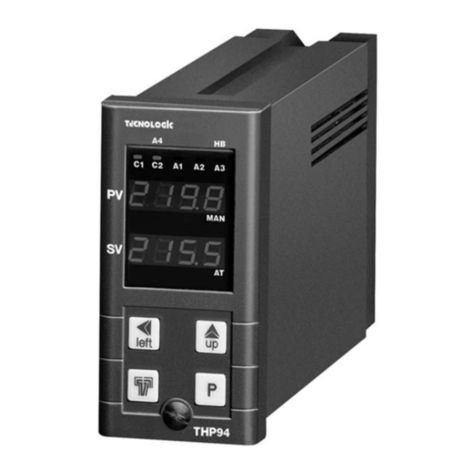
Tecnologic
Tecnologic THP 94 User manual
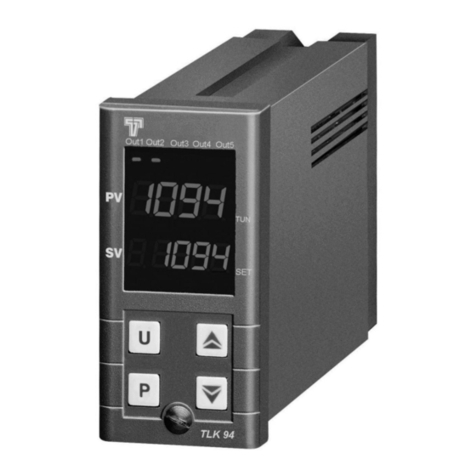
Tecnologic
Tecnologic TLK 94 User manual
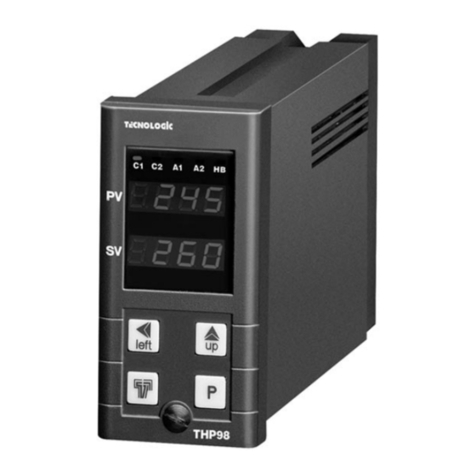
Tecnologic
Tecnologic THP 98 User manual
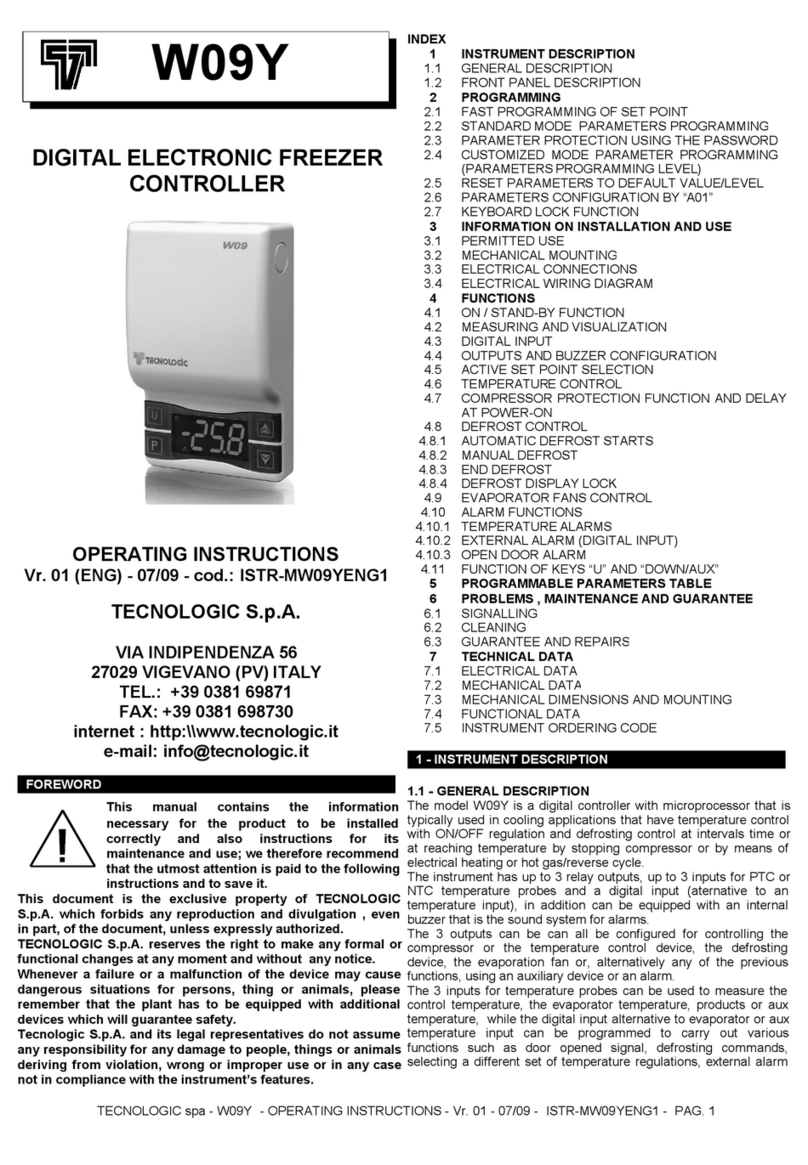
Tecnologic
Tecnologic W09Y User manual
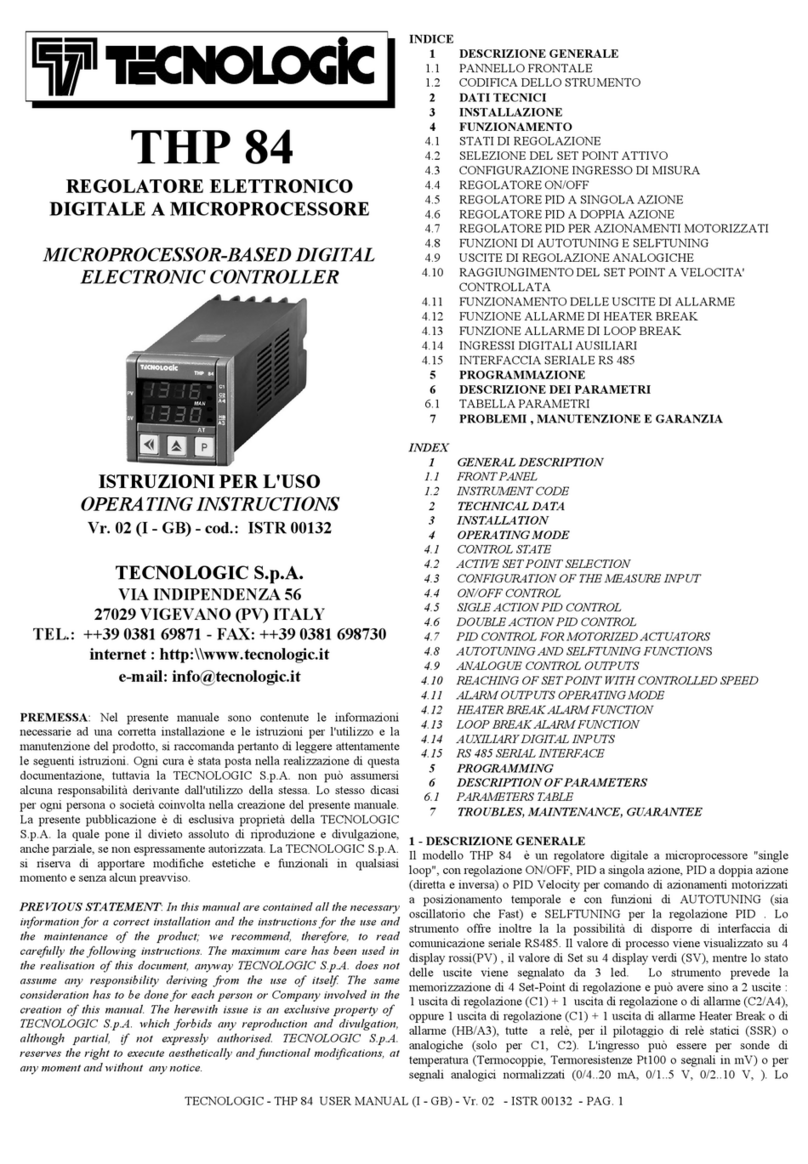
Tecnologic
Tecnologic THP 84 User manual

